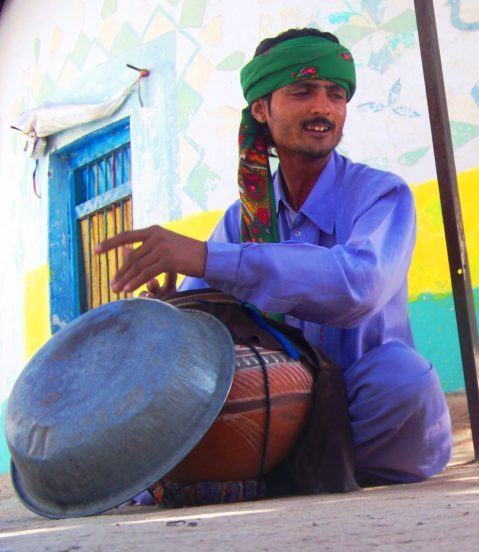
Hailing from village Bhirandiyara, Danabhai also sings Sindhi Kafi and and other folk songs.
Sindh Courier
Kutch or Kachh district has a rich culture of folk music and dance. People here are very fond of folk music and dance. Sindh folk music existed here since ancient periods. It started from the ancient people who were used to invent new sounds for expressing their sentiments and feelings. Gradually, this music further developed as part of their culture.
There are number of folk instruments used by Kachhi people like tabla, sharnai, nagara, murli, janjhra, manjira, khanjari, gharro or ghaghar (clay pot), flute, duff, dholak, damaru, daklu, nagfani, borrindo. These music instruments are linked with a number of aspects of Kachhi people and their culture. The music is very much influenced by Sufi and folk songs.
Here we are going to introduce Danabhai Bharmal, a Gharro player. Gharro is a baked earthen pot of an average size. A special variety also known as Ghaghar. Gharro or Ghaghar is arrhythmic instrument. The variety of Tals is manipulated on the side walls and other on the mouth of the jar. Traditionally, Gharro or Ghaghar is played to the accompaniment of Surando.
As a child Dana admired the sound of Dhol. Not just the sound but the sway the instrument had on the listener. Also, as a child, he used to spend lots of time with his father’s tape recorder. Playing old Hindi songs. Repeatedly. And to be nourished by the soulfulness of the old Hindi songs.
The cheerfulness of Dhol instrument and the melody of the old Hindi songs shaped the musicality of Dana Bharmal. That’s the sound he pursued with Gharro Ghambelo, a traditional folk instrument from his village. A cheerful percussion sound that is soothing.
But he had to start his childhood journey as a musician with a steel plate and a small Gharro. As a substitute for the actual Gharro-Ghambelo instrument because he didn’t have access to one. He sang traditional folk songs accompanied with music he played on the steel plate and the small Ghado. Soon he earned a fame for himself in his school. As an entertainer but also as a talented musician. It took him a while before he could own an actual Gharro Ghambelo instrument, because of the lack of resources.
Watch the Video: Dana Bharmal (right) on Gharro Ghambelo doing jugalbandhi with Adam Latif on Chang instrument
Meanwhile he tagged along with other folk musicians doing Reyans (folk music evenings) in an around his village. To get the feel for the stage and also a chance to perform on Gharro Ghambelo. Eventually he earned invitations to perform in music programs and to make a small livelihood out of his music. Till date Dana has done more than 500 programs. Travelled many places in India with his music and also got invited to perform in Brazil and Indonesia.
But music alone doesn’t sustain Dana’s family. He also runs a small craft shop with his wife and daughters. They make toys from old clothes. And some quilts. His wife is also an accomplished bead artisan and an embroidery artist.
He is also an accomplished singer with few signature songs to his credit. He specializes in the folk genres of Sindhi Kafi and Lok Sangeet. He often writes his own lyrics, which is a very rare today in the folk music scene of Kachh. He now practices music with his son and daughter. They want to be singers, and learn the instrument Manjira.
Dana played an important role in the formation of Kala Varso and to take forward its mission to sustain folk music traditions of Kutch and its artists. He sits on the board of Kala Varso, an organization to promote folk singers of Kutchh. He participated in Reeyaz Shala – Folk music school in Kutch – training programs to further his music understanding in terms of Sur (melody) and Taal (rhythm).
The locals call him ‘Kalakar’ – an accomplished artist. He won awards and many felicitations. But more importantly inspired many young musicians in his Taluka, including his brothers, to follow their musical heritage.
__________________
Courtesy: Kalavarso, Katchh